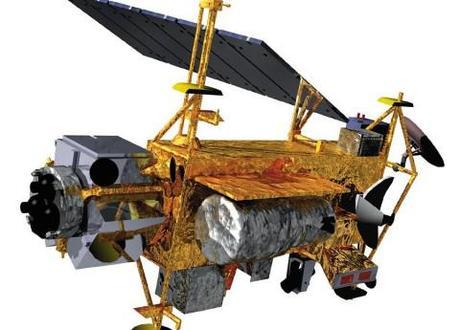
UARS: coming to an Earth near you. Photocredit: Wikipedia
Are we all doomed – again? This time it isn’t the financial crisis, it’s Asterix’s greatest fear – the sky is falling on our heads. An actual real 20 year old, 34 foot long, 6.5 tonne Upper Atmosphere Resarch Satellite (or, as its friends call it, UARS) is currently making its way to Earth at 18,000 miles per hour. Nasa (the space agency) has warned that it’s not just going to fall gently into the sea – it could land anywhere. Yes, ANYWHERE. That means you could wake up tomorrow with a large chunk of outerspace in your bedroom. It turns out that Nasa deliberately – yes, DELIBERATELY – altered its orbit in order to make it crash – but it’s coming down faster than expected thanks to altered atmospheric conditions. Nasa says, however, that there’s only a 1 in 3,200 chance of it hitting a person. Most of you will have worked out by now that that’s 1 in 21 trillion. So perhaps we needn’t worry quite so much. Also, it’s happened before – the Skylab crash of 1979, which didn’t really cause any trouble at all.
The machine, which is apparently the “size of a bus”, according to The Daily Mail, will break up as soon as it enters Earth’s atmosphere. But that won’t mean it will collapse into manageable chunks. Oh no. Instead, it will merrily hurl monstrous lumps of metal around. Nasa is helpfully predicting that it can only predict where it will land to “the nearest 6,000 miles.” Thanks, Nasa! So that could be anywhere between Inverness and South America. It won’t, however, hit the United States of America. The satellite is being tracked by RAF Fylingdales on the North York moors, which is using its giant radar to watch the beast. Nasa orbital debris scientist Mark Matney admitted in The Daily Mail: “We know it is going to hit somewhere between 57 north and 57 south, which covers most of the inhabited world, unfortunately.” Don’t worry though – if you do get hit, Insurance Journal says you’ll be covered.
“Anybody who finds a piece of the satellite should stay away from it and call the police and let them deal with it,” said Nasa spokesman Steve Cole, quoted on The Daily Mail.
Just a can of Coke. Lottie Williams, reported The Daily Telegraph, in 1997, was the only person known to have been struck by space debris. She was hit on the shoulder by a bit of the Delta rocket – a bit that weighed “the same as a drinks can.”
“We’ve had a lot of debris come down, sometimes 100 objects a year. We’ve had only one person brushed on the shoulder. As far as the sky falling? I don’t think so,” said Dr William Ailor, director of the Aerospace Corporation in a video on The Daily Telegraph.
Flee to the hills! Well – not really. The debris, said BBC news, will include “three batteries, four wheel rims and four fuel tanks,” adding that it will fall “10 times quicker than Usain Bolt.” If you’re really worried about it then you should go to Quebec, or further south than Argentina. But doing so will probably be riskier than staying put.
“Potentially, you could get out of the way,” said Richard Crowther of the UK Space Agency, somewhat nonchalantly.
Some very exciting footage of the satellite is here:
Be unafraid. Be very unafraid. What is it? asked The Guardian’s Pass Notes. “Some kind of virus?” Re-entry has been certain since the satellite’s decommissioning in 2005. The odds of winning the lottery are one in 13,983,816; of being eaten by a shark, one in 11 million: “So I should be 3,400 times more afraid of this satellite than I was after I saw Jaws.”
“If I found out it was heading anywhere near me, I’d be outside watching for it — you can’t dodge something you can’t see,” said Lottie Williams, helpfully, to the Toronto Sun.

